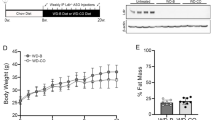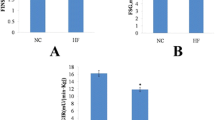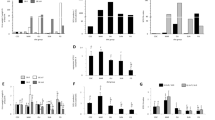Abstract
In humans, diets rich in fish oil (containing n-3 FA) decrease the incidence of coronary artery diseases. This is thought to be caused by the induction in liver and skeletal muscle of genes involved in lipid oxidation, and to the repression in liver and adipose tissue of genes responsible for lipogenesis. n-3 FA are known to reduce the synthesis of FA and TG in the liver, resulting in a decrease of plasma concentrations of TG-rich lipoproteins. On the other hand, little is known of a possible effect of n-3 FA on HDL metabolism. To investigate this question, female C57BI/6J mice were fed an n-3 FA-enriched diet for 16 wk. As expected from previous studies, we found that total cholesterol, TG, and phospholipids were reduced in the plasma of treated mice. We also found that HDL-cholesterol decreased after this treated and that the in vivo fractional catabolic rate of HDL-cholesteryl ester was significantly higher in treated mice than in control mice fed a standard diet. Consistent with these results, treated mice exhibited increased uptake of HDL-cholesteryl ester in the liver. Moreover, quantitative reverse transcriptase-PCR analysis showed a two-to threefold increase in scavenger receptor B-1 gene expression. Taken together, these results suggest that an n-3 FA-enriched diet stimulates one step in the reverse cholesterol transport in mice, probably by increasing the amount of the scavenger receptor class B-1. These effects of n-3 FA on HDL metabolism may contribute to their beneficial effects on the vasculature.
Similar content being viewed by others
Abbreviations
- FPLC:
-
fast protein liquid chromatography
- MEM:
-
Eagle's minimal essential medium
- PPARα:
-
peroxisome proliferator-activated receptor α
- RT-PCR:
-
reverse transcriptase-PCR
- SR:
-
scavenger receptor
References
Dyerberg, J., and Bang, H.O. (1982) A Hypothesis on the Development of Acute Myocardial Infarction in Greenlanders, Scand. J. Clin. Invest. 42 (Suppl. 161), 7–13.
Bang, H.O., and Dyerberg, J. (1973) The Composition of Food Consumed by Greenland Eskimos, Acta Med. Scand. 200, 69–73.
Sangor, R., and Gillott, T. (1991) Long-Term Reduction in Reinfarction Rate, Blood Fibrinogen, Triglyceride and Total Cholesterol in Patients Taking Omega-3 Fatty Acids for Ischaemic Heart Disease, in Fish Oil and Blood Vessel Wall Interactions (Vanhoutte, P.M., and Douste-Blazy, Ph., eds.), pp. 149–160, John Libbey Eurotext, Paris, France.
Nieuwenhuys, C.M., and Hornstra, G. (1998) The Effects of Purified Eicosapentaenoic and Docosahexaenoic Acids on Arterial Thrombosis Tendency and Platelet Function in Rats, Biochim. Biophys. Acta 1390, 313–322.
Heller, A., Koch, T., Schmeck, J., and van Ackern, K. (1998) Lipid Mediators in Inflammatory Disorders, Drugs 55, 487–496.
Fox, P.L., and Dicorleto, P.E. (1988) Fish Oils Inhibit Endothelial Cell Production of Platelet-Derived Growth Factor-like Protein, Science 241, 453–456.
Weber, C., Erl, W., Pietsch, A., Danesch, U., and Weber, P. (1995) Docosahexaenoic Acid Selectively Attenuates Induction of Vascular Cell Adhesion Molecule-1 and Subsequent Monocytic Cell Adhesion to Human Endothelial Cells Stimulated by Tumor Necrosis Factor-alpha, Arterioscler. Thromb. Vasc. Biol. 15, 622–628.
Phillipson, B.E., Rothrock, D.W., Connor, W.E., Harris, W.S., and Illingworth, D.R. (1985) Reduction of Plasma Lipids, Lipoproteins, and Apoproteins by Dietary Fish Oils in Patients with Hypertriglyceridemia, N. Engl. J. Med. 312, 1210–1216.
Harris, W.S., Connor, W.E., Illingworth, D.R., Rothrock, D.W., and Foster, D.M. (1990) Effects of Fish Oil on VLDL Triglyceride Kinetics in Humans, J. Lipid Res. 31, 1549–1558.
Rustan, A.C., Nossen, J.O., Christiansen, E.N., and Drevon, C.A. (1988) Eicosapentaenoic Acid Reduces Hepatic Synthesis and Secretion of Triacylglycerol by Decreasing the Activity of Acyl-coenzyme A:1,2-Diacylglycerol Acyltransferase, J. Lipid Res. 29, 1417–1426.
Hebbachi, A.M., Seelaender, M.C., Baker, B.W., and Gibbons, G.F. (1997) Decreased Secretion of Very-Low-Density Lipoprotein Triacylglycerol and Apolipoprotein B Is Associated with Decreased Intracellular Triacylglycerol Lipolysis in Hepatocytes Derived from Rats Fed Orotic Acid or n-3 Fatty Acids, Biochem. J. 325, 711–719.
Harris, W.S. (1997) n-3 Fatty Acids and Serum Lipoproteins: Human Studies, Am. J. Clin. Nutr. 65 (Suppl.), 1645S-1654S.
Hansen, J.B., Grimsgaard, S., Nilsen, H., Nordoy, A., and Bonaa, K.H. (1998) Effects of Highly Purified Eicosapentaenoic Acid and Docosahexaenoic Acid on Fatty Acid Absorption, Incorporation into Serum Phospholipids and Postprandial Triglyceridemia, Lipids 33, 131–138.
Roche, H.M., and Gibney, M.J. (1999) Long-Chain n-3 Polyunsaturated Fatty Acids and Triacylglycerol Metabolism in the Postprandial State, Lipids 34 (Suppl.), S259-S265.
Ren, B., Thelen, A.P., Peters, J.M., Gonzalez, F.J., and Jump, D.B. (1997) Polyunsaturated Fatty Acid Suppression of Hepatic Fatty Acid Synthase and S14 Gene Expression Does Not Require Peroxisome Proliferator-Activated Receptor Alpha, J. Biol. Chem. 272, 26827–26832.
Kim, H.J., Takahashi, M., and Ezaki, O. (1999) Fish Oil Feeding Decreases Mature Sterol Regulatory Element-Binding Protein 1 (SREBP-1) by Down-regulation of SREBP-1c mRNA in Mouse Liver. A Possible Mechanism for Down-regulation of Lipogenic Enzyme mRNAs, J. Biol. Chem. 274, 25892–25898.
Eisenberg, S. (1984) High Density Lipoprotein Metabolism, J. Lipid Res. 25, 1017–1058.
Chen, C.H., and Albers, J.J. (1982) Characterization of Proteoliposomes Containing Apoprotein A-I: A New Substrate for the Measurement of Lecithin: Cholesterol Acyltransferase Activity, J. Lipid Res. 23, 680–691.
Peuchant, E., Wolff, R., Salles, C., and Jensen, R. (1989) One-Step Extraction of Human Erythrocyte Lipids Allowing Rapid Determination of Fatty Acid Composition, Anal. Biochem. 181, 341–344.
de la Llera Moya, M., Atger, V., Paul, J.L., Fournier, N., Moatti, N., Giral, P., Friday, K.E., and Rothblat, G. (1994) A Cell Culture System for Screening Human Serum for Ability to Promote Cellular Cholesterol Efflux. Relations Between Serum Components and Efflux, Esterification, and Transfer, Arterioscler. Thromb. 14, 1056–1065.
Bérard, A., Foger, B., Remaley, A., Shamburek, R., Vaisman, B.L., Talley, G., Paigen, B., Hoyt, R.F., Jr., Marcovina, S., Brewer, H.B., Jr., and Santamarina-Fojo, S. (1997) High Plasma HDL Concentrations Associated with Enhanced Atherosclerosis in Transgenic Mice Overexpressing Lecithin-Cholesteryl Acyltransferase, Nat. Med. 3, 744–749.
Morton, R.E., and Zilversmit, D.B. (1981) A Plasma Inhibitor of Triglyceride and Cholesteryl Ester Transfer Activities, J. Biol. Chem. 256, 11992–11995.
Folch, J., Lees, M., and Sloane Stanley, G.H. (1957) A Simple Method for the Isolation and Purification of Total Lipides from Animal Tissues, J. Biol. Chem. 226, 497–509.
Chomczynski, P., and Sacchi, N. (1987) Single-Step Method of RNA Isolation by Acid Guanidinium Thiocyanate-Phenol-Chloroform Extraction, Anal. Biochem. 162, 156–159.
Yoshida, H., Mawatari, M., Ikeda, I., Imaizumi, K., Seto, A., and Tsuji, H. (1999) Effect of Dietary Seal and Fish Oils on Triacylglycerol Metabolism in Rats, J. Nutr. Sci. Vitaminol. 45 (Tokyo), 411–421.
Holub, B.J., Bakker, D.J., and Skeaff, C.M. (1987) Alterations in Molecular Species of Cholesterol Esters Formed via Plasma Lecithin-Cholesterol Acyltransferase in Human Subjects Consuming Fish Oil, Atherosclerosis 66, 11–18.
Leaf, D.A., Connor, W.E., Barstad, L., and Sexton, G. (1995) Incorporation of Dietary n-3 Fatty Acids into the Fatty Acids of Human Adipose Tissue and Plasma Lipid Classes, Am. J. Clin. Nutr. 62, 68–73.
Leaf, A., and Weber, P.C. (1988) Cardiovascular Effects of n-3 Fatty Acids, N. Engl. J. Med. 318, 1349–1357.
Kromhout, D., Bosscheiter, E.B., and DeLozenne Coulander, C. (1985) The Inverse Relation Between Fish Consumption and 20-Year Mortality from Coronary Heart Disease, N. Engl. J. Med. 312, 1205–1209.
Hayek, T., Chajek-Shaul, T., Walsh, A., Azrolan, N., and Breslow, J.L. (1991) Probucol Decreases Apolipoprotein A-I Transport Rate and Increases High Density Lipoprotein Cholesteryl Ester Fractional Catabolic Rate in control and Human Apolipoprotein A-I Transgenic Mice, Arterioscler. Thromb 11, 1295–1302.
Plump, A.S., Azrolan, N., Odaka, H., Wu, L., Jiang, X., Tall, A., Eisenberg, S., and Breslow, J.L. (1997) ApoA-I Knockout Mice: Characterization of HDL Metabolism in Homozygotes and Identification of a Post-RNA Mechanism of ApoA-I Up-regulation in Heterozygotes, J. Lipid Res. 38, 1033–1047.
Gillotte, K.L., Lundkatz, S., de la Llera-Moya, M., Parks, J.S., Rudel, L.L., Rothblat, G.H., and Phillips, M.C. (1998) Dietary Modification of High Density Lipoprotein Phospholipid and Influence on Cellular Cholesterol Efflux, J. Lipid Res. 39, 2065–2075.
Dusserre, E., Pulcini, T., Bourdillon, M.C., Ciavatti, M., and Berthezene, F. (1995) Omega-3 Fatty Acids in Smooth Muscle Cell Phospholipids Increase Membrane Cholesterol Efflux, Lipids 30, 35–41.
Author information
Authors and Affiliations
About this article
Cite this article
Morvan, V.l., Dumon, MF., Palos-Pinto, A. et al. n-3 FA increase liver uptake of HDL-cholesterol in mice. Lipids 37, 767–772 (2002). https://doi.org/10.1007/s11745-002-0959-2
Received:
Revised:
Accepted:
Issue Date:
DOI: https://doi.org/10.1007/s11745-002-0959-2




